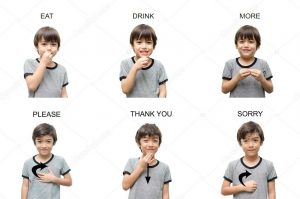
Imagine being hungry but having no way to convey that sensation to others or the ability to get food yourself. Picture your intestines filling up with trapped gas but unable to tell anyone about your pain and helpless to do anything about it. Try telling someone that you have to use the restroom when you have no words or symbols to relay this urge. What happens when you’re thirsty but can’t tell anyone what you need and you can’t get it yourself? This is how many babies and toddlers feel all day, every day. Now, imagine how frustrating that would be!
Babies can be given the power of communicating their needs at such a young age. Children less than one can use their hands to communicate before they can use their words. This proves that children are capable of understanding verbal language at a MUCH younger age than when able to express verbal language. What does that mean?
It means that these babies and toddlers know what they want to communicate but don’t know how to relay the message. So they get frustrated and cry. Wouldn’t you?
As caregivers for these children, caring for them would be so much easier if they could tell us what they need. This is why it is important to understand that we do have the power to give them this ability that can make life so much more pleasant for both child and caregiver. As soon as a child is born, that child is very capable of learning sign language. Using simple signs throughout the day with your baby will give him or her the connection needed between an object or action and two different ways to relay them to others, verbal and sign.
Here is a video of my 15-month-old signing about her day to her cat puppet:
Baby Signing Time with Rachel Coleman has been instrumental in many households, including our own, for both baby and adult to learn sign language together. Stick with the simple signs that both you and your baby will remember and modify those signs however you and your family would like to fit your needs and abilities. Empowering your child with even just a handful of words can make all of the difference.
With daily practice, both you and your child can even communicate with each other from across the room without making a sound. Every time they drink milk, sign milk repetitively. Every time they eat food, start by signing eat repetitively until you can branch off into signing specific foods.
The more you repeat and demonstrate each word, the more ingrained it will become in the language centers of both of your brains.
A great place to start would be these 21 basic signs your baby should know by Parenting.com
